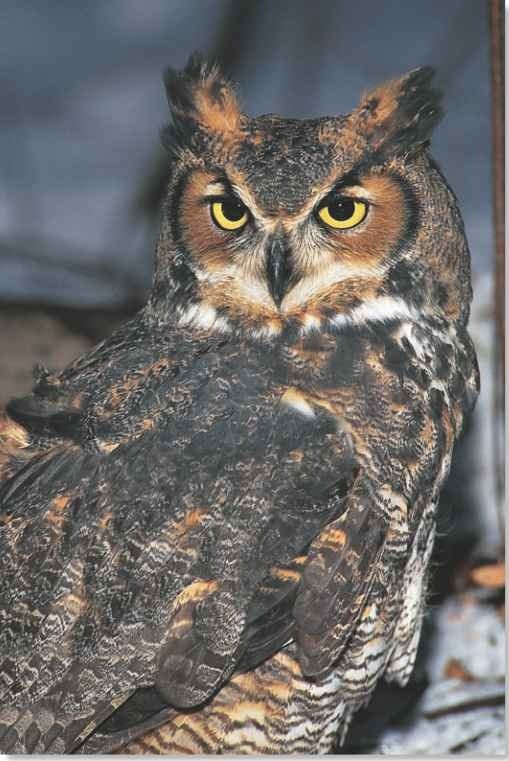ORDER
Strigiform.es
FAMILY
Strigidae
GENUS & SPECIES
KEY FEATURES
• One of the largest | and most powerful of all American owls;
reaches up to 26″ in length and boasts an impressive 5′ wingspan
• Relies on its cryptic plumage for camouflage when roosting during the day
• Powerful hunter, it 1 kills a variety of prey, including other owls and birds of prey
WHERE IN THE WORLD?
Found in North, Central and South America from Alaska and Canada, south through the U.S., Mexico and Central America, to the tip of South America
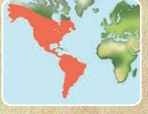
Lifecycle
Using its acute senses of sight and hearing, the great horned owl hunts for prey from atop a tall perch; it then swoops down on its unsuspecting victims with totally silent flight.
Habitat
The great horned owl ranges from central Alaska and most of Canada southward to Argentina; no other owl in the Americas lives in such a wide variety of habitats and climates. Extremely adaptable, this owl inhabits almost any type of environment, including boreal forests, deciduous woodlands, foothill ravines, open grasslands, mangrove forests, deserts and city parks from sea level to over 14,000′. The horned owl prefers areas that provide plenty of shade trees for roosting during the day; however, it is also found in the rocky canyons and steep gullies throughout its range. It favors conifer trees that furnish cover throughout the winter, but it can also be found roosting in deciduous trees such as oaks.
Under cover
Great horned owls rely on dense forests for cover.

One great horned owl nest contained a mouse, a muskrat, a woodcock, a rabbit, two eels, four catfish, four grouse, and 11 rats — all for the owl’s brood.
The hoot of the great horned owl can be heard up to I mile away on still moonlit nights.
The great horned owl can fly at speeds up to 40 mph.
Conservation
Although the great horned owl has very few natural predators and is not globally threatened, its population is declining throughout its range. Known as the fiercest of all predatory birds, the great horned owl has been shot and trapped by farmers and hunters for years throughout its entire range. Since it relies upon trees for roosting and nesting, the clearing of forests for agriculture has not only reduced its numbers but also the populations of its prey.The great horned owl is also killed when struck by automobiles and dies after becoming entangled in wire fences.This bird is listed on Appendix II of CITES, and like all owls is protected by law in the U.S.
Breeding
The great horned owl’s breeding season varies with its geographic location; egg-laying occurs as early as December and January in parts of the U.S. Normally solitary and territorial throughout the year, both the male and female perform noisy courtship displays that include hooting while bowing and fluffing the white feathers below their chins. After mating, the female lays 1-6 (usually 2-3) eggs in an abandoned stick nest built by birds such as the red-tailed hawk; it may also use the empty nests of eagles, osprey herons and even squirrels. The female incubates alone while the male hunts for food; he provides his mate, and later his brood, with an abundance of prey which he deposits in or near the nest. After 26-35 days, the young owls hatch, covered in white downy feathers and totally dependent on their parents. After 9-10 weeks, the chicks are able to fly and soon begin hunting for prey for themselves, usually small animals such as lizards. They remain dependent upon their parents for about one year and do not reach sexual maturity until they are about two years old.
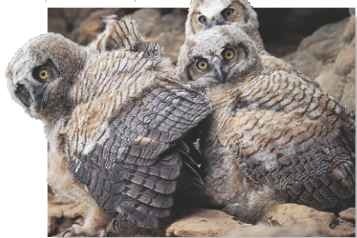
Behavior
Although the great horned owl is active during both day and night, it is mainly nocturnal and emerges to hunt for food after sunset. During the day, the owl roosts in the thick tops of evergreen trees. With its camouflaged plumage, it blends well into its surroundings and remains inconspicuous as it roosts silently in the dense vegetation; its long ear tufts, which resemble broken branches, also help it hide. Like most owls, the great horned owl maintains and defends a territory from other birds, threatening any that come close (right). Well known for its attacks on other owls and hawks, the great horned owl has also been known to attack larger birds, such as bald eagles and golden eagles. These attacks minimize competition for food and nesting sites.
aggressive neighbor

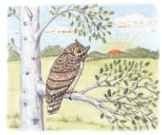
Perching…
A great horned owl perches on the top of a tall aspen tree at dusk and looks out over an open field for prey.
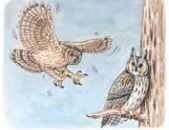
Attacking…
Spotting a long-eared owl perched on a dead branch, the great horned owl goes in for the attack.
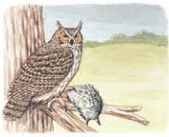
Defending…
Highly territorial, the great horned owl kills the long-eared owl in defense of its territory and to protect its food sources.
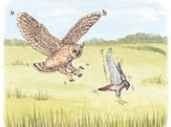
Killing
During the day, the great horned owl attacks and kills other birds of prey, such as the American kestrel.
Food & hunting
The great horned owl is a voracious predator that feeds on a wide variety of prey. Its diet consists mainly of mammals, especially rabbits, hares, mice, meadow voles, bats and squirrels; however, it also eats birds, reptiles, scorpions, fish and insects. Due to its large size and heavy weight, this owl is able to attack and kill other birds of prey, including eagles, hawks and other species of owl. Hunting from a tall tree or other vantage point, the horned owl scans the ground below for prey. Once prey is spotted, the owl silently swoops down and catches its victim in its powerful feet while the sharp talons deliver a fatal blow.
The horned owl then returns to its feeding roost, usually an unoccupied nest or hollow stump, and devours its prey. Daily, the owl regurgitates pellets containing undigested material, such as bones, fur and feathers.
Staying on a while Young owls remain with their parents for one year.
Fierce hunter
The horned owl fiercely hunts for prey, such as mice.
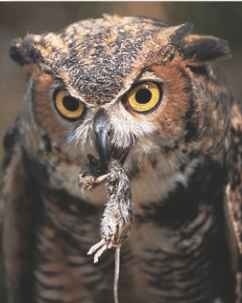
Profile
Great Horned Owl
With its strong talons and sharp, hooked beak, the great horned owl is a fierce and aggressive predator throughout the Americas.
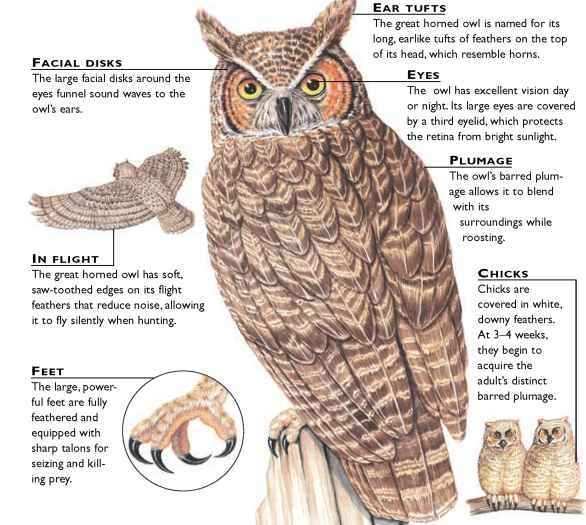
creature comparisons
The spotted eagle owl (Bubo africanus) inhabits the open woodlands, savannahs and riverine woods of Africa south of the Sahara Desert, far removed from the great horned owl, which occurs in the woods and forests of North, Central and South America. Reaching up to 18.5″ and weighing about 1.5 lbs., the spotted eagle owl is much smaller than its western cousin and therefore hunts much smaller prey, such as insects and lizards. Both owls have similar barred plumage, which allows them to blend with their surroundings during the day.

Spotted eagle owl
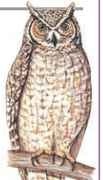
Great horned owl
| VITAL STATISTICS | |
| Weight | 1.5-5.5 lbs.; female larger than male |
| Length | 18-26″ |
| Wingspan | 3-5′ |
| Sexual Maturity | About 2 years |
| Breeding ; Season | Varies with . location |
| Number E of Eggs | Up to 6, usually 2-3 |
| Incubation Period | 26-35 days |
| Fledging Period | 9-10 weeks |
| Breeding I Interval | 1 year |
| Typical I Diet | Mostly birds and mammals |
| Lifespan | Up to 30 years in captivity |
RELATED SPECIES
• The great horned owl is 1 of about 15 species in the genus Bubo; close relatives include the Eurasian eagle owl, B. bubo, and the forest eagle owl, B. nipalensis. The family Strigidae contains about 175 species of true owls found throughout the world. The order Strigiformes comprises about 185 species of owl including 10 species of barn owl in the family Tytonidae.
